时间序列分析在人工智能颗粒物预测中的应用
IF 0.9
4区 计算机科学
Q4 AUTOMATION & CONTROL SYSTEMS
引用次数: 0
摘要
基于人工智能的预测模型提供了良好的空气污染预报员,适合于实时预报系统。其中应用最多的是人工神经网络,它是一种通用逼近器。通常,最好的神经模型(即最准确的神经模型)的识别是基于实验和时间序列分析的结果。本文研究了用人工神经网络预测普洛耶斯蒂市大气颗粒物(PM)污染的时间序列分析。采用两种神经模型:前馈神经模型和径向基神经模型。对于每个模型,我们都试验了几种架构,以便根据均方根误差和均方误差确定最准确的架构。实验数据集包括2008-2012年Ploiesti市PH-6空气质量监测站5个时间序列的PM10、CO、NO2、NOx和SO2 5种空气污染物的浓度测量数据。本文章由计算机程序翻译,如有差异,请以英文原文为准。
Applying Time Series Analysis for Artificial Intelligence Based Particulate Matter Prediction
Artificial intelligence based prediction models provide good air pollution forecasters, proper to real time forecasting systems. Among them, artificial neural networks are the most used ones, being universal approximators. Usually, the identification of the best neural model (i.e. most accurate one) is based on experiments and results of time series analysis. The paper focuses on time series analysis for particulate matter (PM) air pollutant prediction with artificial neural networks in the Ploiesti city. Two types of neural models were used: feed forward and radial basis function. For each model we have experimented several architectures in order to identify the most accurate one in terms of root mean square error and average square error. The experimental datasets include five time series with concentration measurements of five air pollutants, PM10, CO, NO2, NOx, and SO2 in the period 2008-2012 at PH-6 air quality monitoring station from the Ploiesti city.
求助全文
通过发布文献求助,成功后即可免费获取论文全文。
去求助
来源期刊

Modeling Identification and Control
工程技术-计算机:控制论
CiteScore
3.30
自引率
0.00%
发文量
6
审稿时长
>12 weeks
期刊介绍:
The aim of MIC is to present Nordic research activities in the field of modeling, identification and control to the international scientific community. Historically, the articles published in MIC presented the results of research carried out in Norway, or sponsored primarily by a Norwegian institution. Since 2009 the journal also accepts papers from the other Nordic countries.
 求助内容:
求助内容: 应助结果提醒方式:
应助结果提醒方式:


